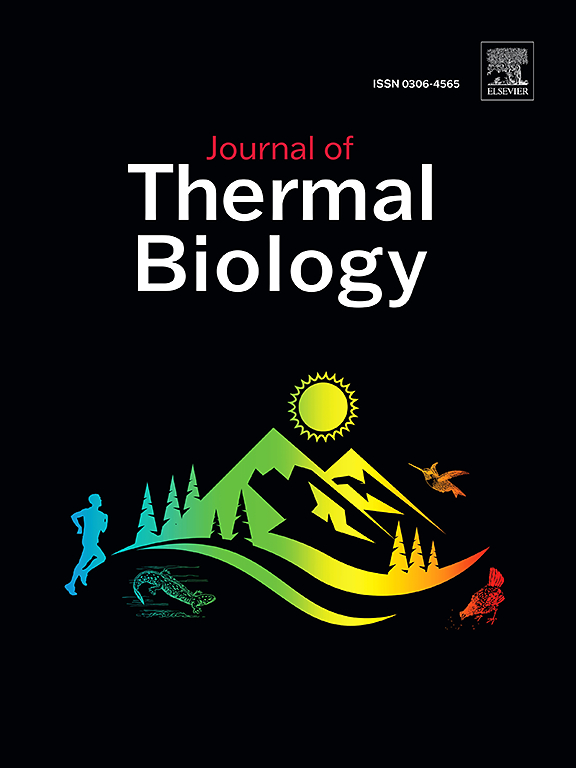低温环境下不同冷驯化方式对小鼠运动能力的影响。
IF 2.9
2区 生物学
Q2 BIOLOGY
引用次数: 0
摘要
目的:研究低温环境下不同的冷驯化策略对雄性小鼠运动性能的影响。方法:雄性小鼠在8周内接受5种不同的驯化方案:浸泡在10°C(10°CI)或20°C(20°CI),游泳在10°C(10°CS), 20°C(20°CS)或34°C(34°CS)。在前2周,驯化时间从每天30分钟逐渐减少到每天3分钟,水温从34°C降低到目标水平,随后持续暴露6周。在整个研究过程中监测体重、食物摄入量和直肠温度。适应后评估包括低温衰竭运动能力测试;肠道菌群16s rDNA测序;以及与棕色脂肪产热、骨骼肌合成和降解相关的基因表达的量化。结果:(1)驯化8周后,暴露于10°C和20°C水的小鼠血清肾上腺素和血管紧张素II水平均未显著升高。(2)低温条件下,低温驯化延长了耐久时间,以20°CI、10°CS和20°CS组最为显著。(3)与对照组(C)相比,20°CI和10°CS组UCP1、IGF-1、AKT、mTOR基因表达水平显著升高(P)。低温环境下运动可以激活产热和骨骼肌合成相关基因,增加产生短链脂肪酸的有益菌的丰度,从而调节宿主代谢,加速冷驯化的形成,增强低温环境下的运动能力。本文章由计算机程序翻译,如有差异,请以英文原文为准。

Effect of different cold acclimation methods on the exercise capacity of mice in low-temperature environments
Objective
This study aimed to evaluate the effects of different cold acclimation strategies on exercise performance in male mice exposed to low-temperature environments.
Methods
Male mice were subjected to five distinct acclimation regimens over 8 weeks: immersion at 10 °C (10 °CI) or 20 °C (20 °CI), swimming at 10 °C (10 °CS), 20 °C (20 °CS), or 34 °C (34 °CS). During the first 2 weeks, the acclimation time progressively decreased from 30 min to 3 min per day, and the water temperatures were lowered from 34 °C to the target levels, followed by 6 weeks of consistent exposure. Body weight, food intake, and rectal temperature were monitored throughout the study. Post-acclimation assessments included low-temperature exhaustion exercise ability testing; 16 S rDNA sequencing of gut microbiota; and quantification of gene expression related to brown adipose thermogenesis, skeletal muscle synthesis, and degradation.
Results
(1) After 8 weeks of acclimation, neither serum adrenaline nor angiotensin II levels significantly increased in mice exposed to 10 °C or 20 °C water. (2) Cold acclimation extended the endurance time under low-temperature conditions, notably in the 20 °CI, 10 °CS, and 20 °CS groups.
(3) Compared with the control (C) group, the 20 °CI and 10 °CS groups showed significantly increased UCP1, IGF-1, AKT, and mTOR gene expression levels (P < 0.05). The expression levels of MAFbx and MuRF1 genes in the 10 °CS and 20 °CS groups significantly decreased compared with those in the C group (P < 0.05). (4) Compared with the C group, the 20 °CI, 10 °CS, and 20 °CS groups demonstrated significant changes in intestinal microbiota diversity. Specifically, the abundance of Akkermansia strains significantly increased in the 20 °CI and 10 °C S groups. The abundance of Ruminococcus and Prevotellaceae_UCG-001 significantly increased in the 20 °C S group.
Conclusion
Exercise in cold environments can activate genes related to heat production and skeletal muscle synthesis and increase the abundance of beneficial bacteria producing short-chain fatty acids, thereby modulating host metabolism, accelerating the formation of cold acclimation, and enhancing exercise capacity in low-temperature environments.
求助全文
通过发布文献求助,成功后即可免费获取论文全文。
去求助
来源期刊

Journal of thermal biology
生物-动物学
CiteScore
5.30
自引率
7.40%
发文量
196
审稿时长
14.5 weeks
期刊介绍:
The Journal of Thermal Biology publishes articles that advance our knowledge on the ways and mechanisms through which temperature affects man and animals. This includes studies of their responses to these effects and on the ecological consequences. Directly relevant to this theme are:
• The mechanisms of thermal limitation, heat and cold injury, and the resistance of organisms to extremes of temperature
• The mechanisms involved in acclimation, acclimatization and evolutionary adaptation to temperature
• Mechanisms underlying the patterns of hibernation, torpor, dormancy, aestivation and diapause
• Effects of temperature on reproduction and development, growth, ageing and life-span
• Studies on modelling heat transfer between organisms and their environment
• The contributions of temperature to effects of climate change on animal species and man
• Studies of conservation biology and physiology related to temperature
• Behavioural and physiological regulation of body temperature including its pathophysiology and fever
• Medical applications of hypo- and hyperthermia
Article types:
• Original articles
• Review articles
 求助内容:
求助内容: 应助结果提醒方式:
应助结果提醒方式:


